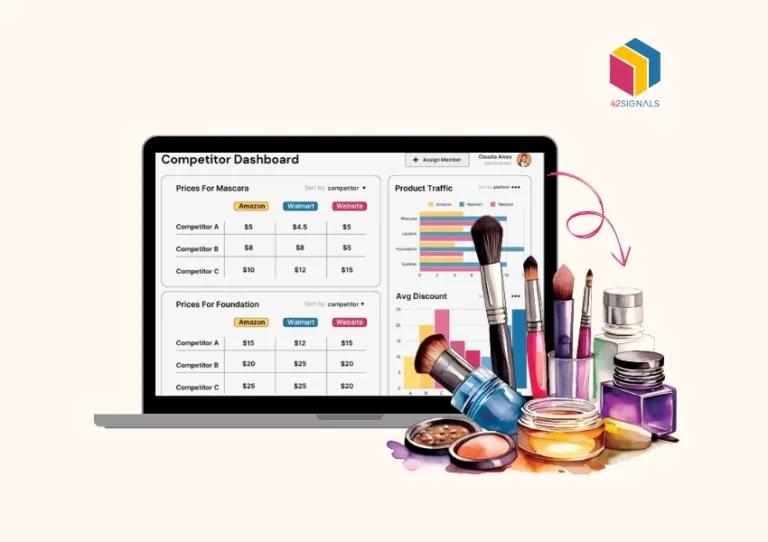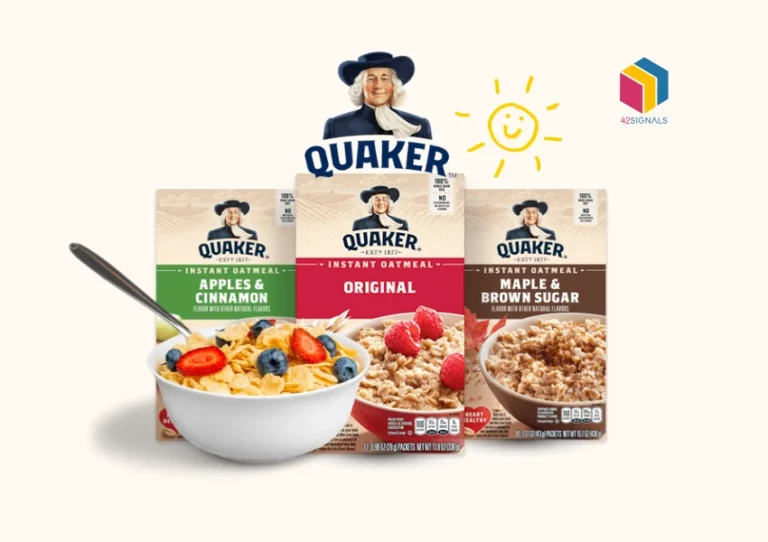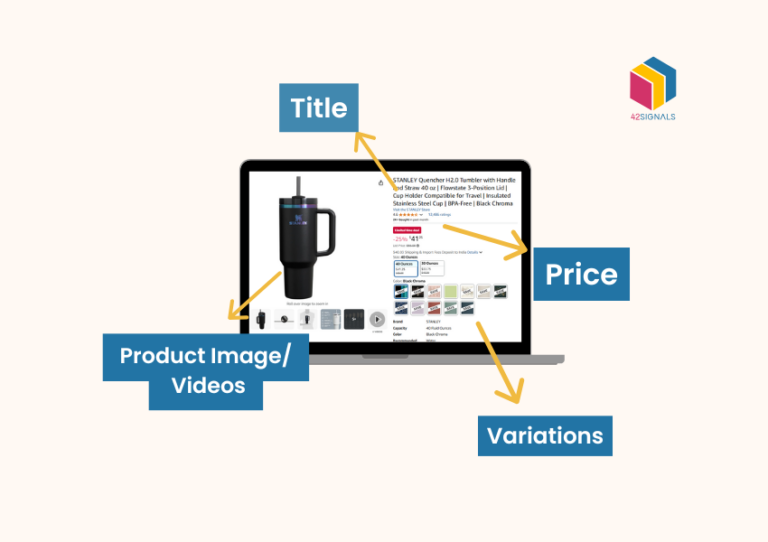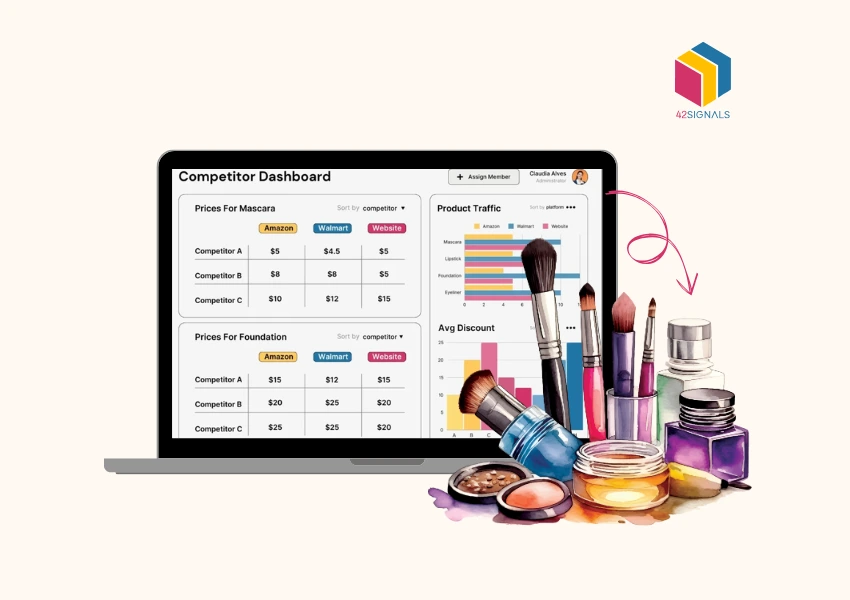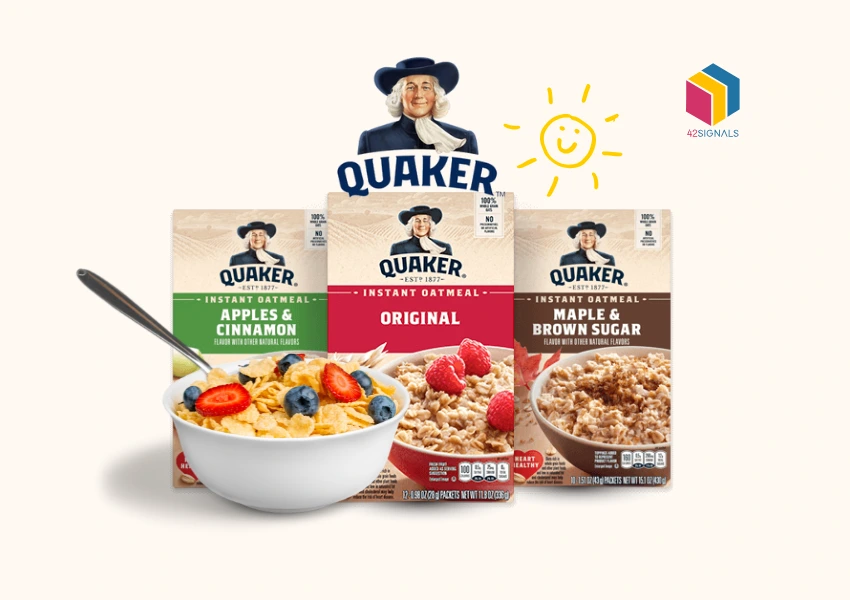Are you aware that 70% of Amazon shoppers never click past the first page of search results? This indicates that if your product is not ranking for the appropriate keywords, it is nearly impossible for potential customers to find it. Amazon works differently from traditional search engines because it was established for product discovery, and as a result, sellers on the platform have to put in extra work to boost visibility and conversions through keyword optimization.
Amazon keyword analysis is what assists businesses in determining the most appropriate keywords for searches which will bring traffic and improve sales ranking. The use of big data and sophisticated technologies like 42Signals enables brands to optimize their listings, outsmart competitors, and maximize market share.
This guide analyzes the value of the Amazon keyword analysis and how users of 42Signals can improve product visibility and sales figures.
Why Amazon Keyword Analysis is Crucial for Your Brand?
Amazon’s A9 algorithm (search algorithm) ranks products according to relevance, sales, and customer interaction. With missing well-optimized keywords, your listing will stand no chance of being viewed in searches done by buyers even when there is a high need for the product. Sellers who are looking to increase sales and beat the competition need to understand the relationship between keywords and rankings.
Through keyword analysis, your keyword ranking dashboard is enhanced and search terms can be monitored over time. It also allows brands to improve their share of search, which is the ratio of searches that include the brand’s products compared to the competition.
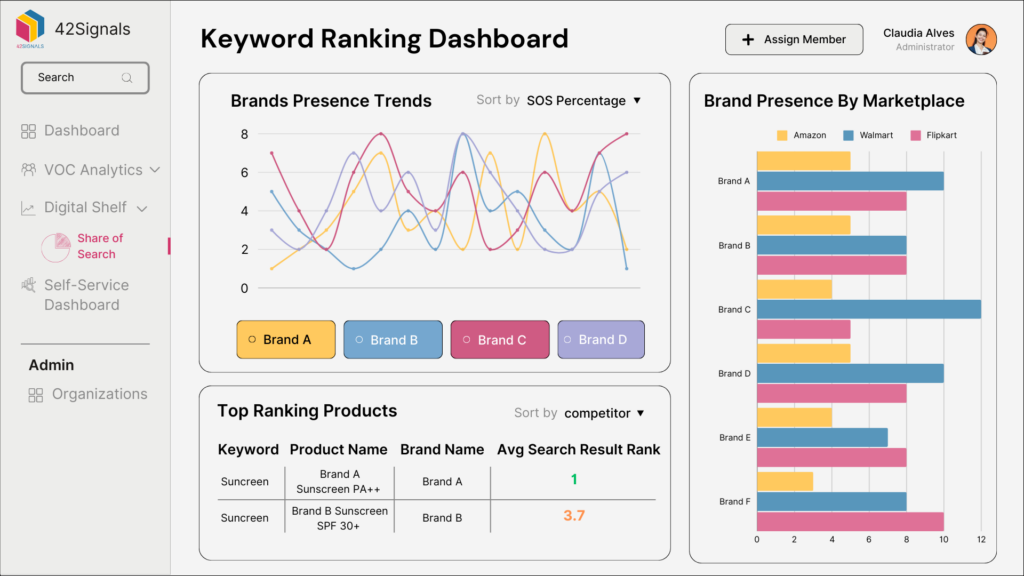
In addition, keyword research offers relevant targeted keyword suggestions which ensures your listings receive appropriate audience attention. Moreover, voice of customer analytics allows brands to articulate product descriptions in a manner their customers will appreciate enabling the brands to use the customers’ language and sentiment.
Inadequate keyword optimization can cause your product to be lost in search results, leading to missed revenue opportunities. Brands can improve visibility and conversions by strategically utilizing Amazon keyword analysis.
How to Conduct Amazon Keyword Analysis with 42Signals?
42Signals provides keyword strategies for brands on Amazon and as such gives data-led solutions for optimization of an Amazon keyword strategy.
From providing effective search terms, and tracking keyword performance to analyzing customer insights, these tools include everything needed to perform Amazon keyword analysis.
1. Identify High-Impact Keywords
Choosing the correct keywords is the basis of an effective Amazon strategy. Thanks to 42Signals’ Amazon scraping technology, brands can easily find search terms that bring traffic and conversions. With the help of real-time search trends monitoring, brands can locate high-volume keywords and low-competition keywords that can easily rank.
More specific search phrases, known as long-tail keywords, generally have higher conversion rates. A brand can target, for example, ‘best noise-canceling wireless earbuds for workouts’ instead of simply ‘wireless earbuds.’ These narrow-down keywords bring in a specific audience while not facing high competition raising the chances of ranking higher.

Image Source: Prophotostudio
2. Track Keyword Performance Over Time
Keyword performance is unstable because of competition, algorithm changes, and shifts in consumer behavior. Knowing which keywords provide traffic and conversions is easier with a keyword ranking dashboard, and 42Signals makes it possible for brands to track keyword trends.
When brands note a decline in a keyword’s performance, they can explore reasons like higher competition, poor product descriptions, or changes in prices. Regular tracking of keyword performance allows brands to stay competitive and refresh their listings to maximize views.
3. Get AI-Powered Keyword Suggestions
Locating the ideal keyword is often difficult, but 42Signals offers AI-powered suggestions to make the task less daunting. This helps brands identify related search terms that potential customers are likely to use. By incorporating these suggestions into product titles, bullet points, and descriptions, sellers can draw more relevant traffic to their products.
Such recommendations also help brands utilize under-served, valuable keywords that many sellers fail to capitalize on, thereby expanding their share of search. Instead of relying on vague search terms, brands are able to focus on customer intent, which improves visibility and conversion rates.
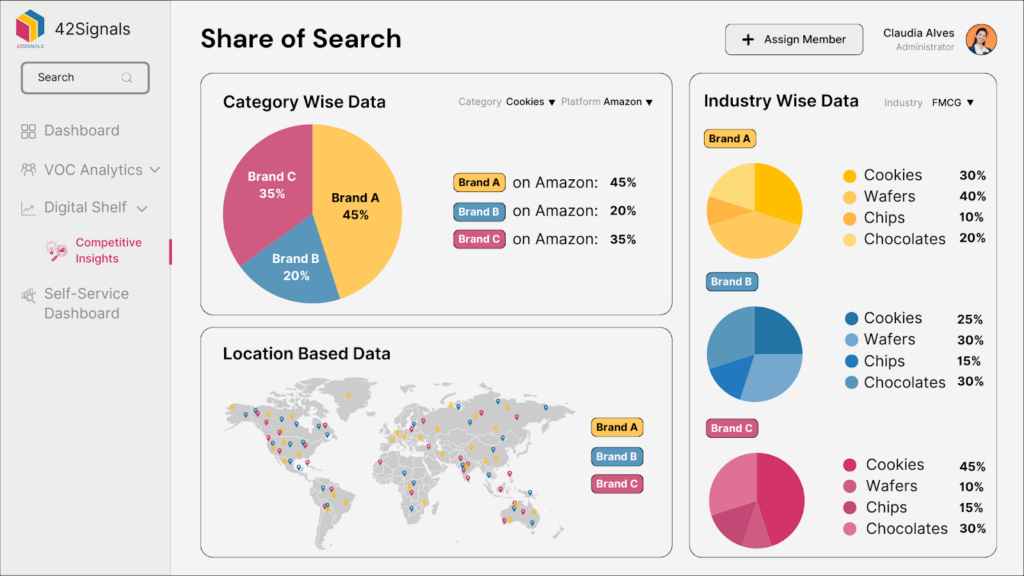
4. Leverage Voice of Customer Analytics
Analyzing customer sentiment is crucial while optimizing for keywords. Through voice of customer analytics, brands can sift through reviews and Q&A sections to look for phrases frequently used by customers. This helps brands enhance their product description by utilizing the language customers use while talking about the product to list it.
For instance, if numerous customers highlight the word “lightweight” as an advantage, using it in the title and description of the product will improve search relevance. Negative reviews are useful too as they can point out things like lack of product durability or performance that many customers complain about. Brands can improve their search rankings and sales by aligning their listings with customer feedback.
5. Analyze Competitor Keyword Strategies
Conducting a competitor analysis is critical in the Amazon marketplace, especially for Amazon retailers. The customer sentiment analysis together with monitoring competitor keyword performance, and pricing analysis provided by 42Signals’ Amazon data insights helps brands follow their rival’s keyword competition within a specific market. Understanding what keywords competitors rank for can help brands improve their listings and gain market share.
If a competitor is ranking on the first page for the keyword “organic face serum,” you can analyze their product title, product description, and pricing to see what can be optimized. Companies can then adjust their keyword strategy to attract the same keywords, and phrases, or choose to provide a competing product based on distinct selling propositions.
How to Optimize Your Amazon Listings for Higher Rankings?
After keyword-based analysis, the next task is to optimize product listings so that their rank on search results is higher. Having a properly optimized listing results in increased brand visibility and therefore sales.
1. Optimize Product Titles with Targeted Keywords
The combination of keywords provided in your title is a significant factor in determining your ranking position on Amazon. The title contains primary keywords, describes your product, and portrays the title in an attractive manner to buyers. From a vague title such as “Wireless Earbuds”, a more optimized title would be:
“Wireless Earbuds – Noise Cancelling, Waterproof Sport Earphones with Bluetooth 5.0 for Running and Gym”
This title contains a myriad of keywords but the order it is presented still makes it easy to understand for consumers.
2. Enhance Bullet Points with Keyword Optimization
Bullet points provided by Amazon serve to highlight key features, benefits of the products, and main keywords. For example:
- Superior Sound Quality – Enjoy crystal-clear audio with advanced noise cancellation.
- Long Battery Life – Up to 30 hours of continuous playback with a fast-charging case.
- Ergonomic & Waterproof – Designed for comfort and built to withstand sweat and rain.
All bullet points should aim to provide useful information to consumers while seamlessly blending powerful keywords.
3. Write a Keyword-Rich Product Description
A compelling product description should include primary and secondary keywords while addressing common customer concerns. Instead of stating, “These earbuds have long battery life,” a more optimized version could be:
While optimizing a product description for SEO, one must consider retention factors such as the worries of the customer besides primary and secondary keywords. An example way of putting it would be, “These earbuds have long battery life.” but, an optimized version can translate to:
“Designed for long-lasting performance, these wireless earbuds feature Bluetooth 5.0, noise cancellation, and a 30-hour battery life—perfect for workouts, travel, and daily use.”
The description above is informative, captures the interest of readers as well as has positive implications for search optimization on Amazon.
4. Optimize Backend Search Terms
There are more features to such accounts as Amazon accounts: for example, they allow hidden backend search terms that enhance SEO optimization. Brands should use these areas to include synonyms, alternative spellings, and relevant keyword variations that might not fit. For example, backend keywords for wireless earbuds might include:
“wireless earphones, Bluetooth headphones, workout earbuds, waterproof earbuds, gym headphones”
Fulfilling these gaps ensures that the product can be easily found with different keyword phrases.
Conclusion
Understanding Amazon keyword analysis is one of the crucial features for brands aiming at gaining visible products, their rankings, or selling. Enhanced features of 42Signals enable sellers to identify high-impact keywords, track these through a keyword tracking tool, and provide AI-powered keyword suggestions geared towards listing optimization which sellers can use.
Voice of the customer analysis allows brands to improve their content through actual customer feedback, just as competitor keyword analysis offers strategic benefits. Optimizing the listings’ product titles, descriptions, and backend search terms guarantees an increase in both clicks and conversions.
With a sophisticated data-backed approach to Amazon keyword analysis, brands improve their share of search, outperform competitors, and achieve longevity on the platform.Get started with 42Signals to optimize your brand strategy and reach new peaks on Amazon. Schedule a demo now!

